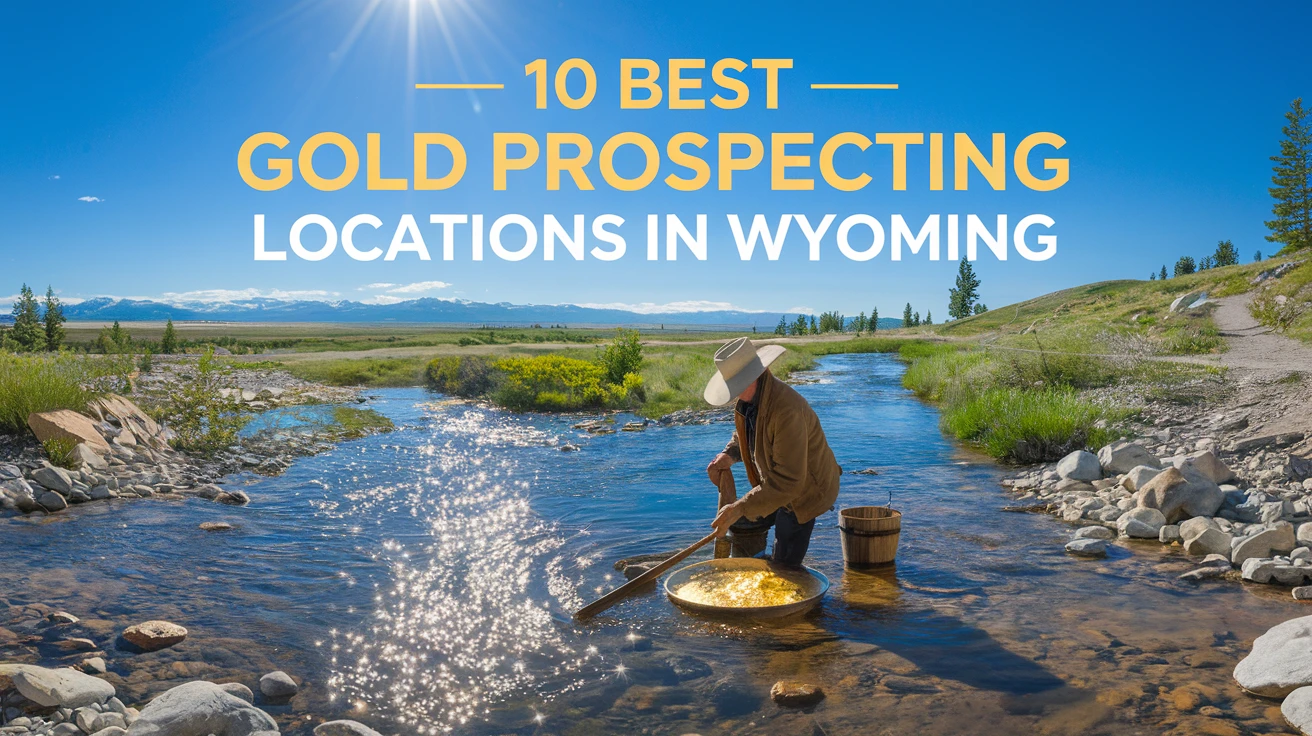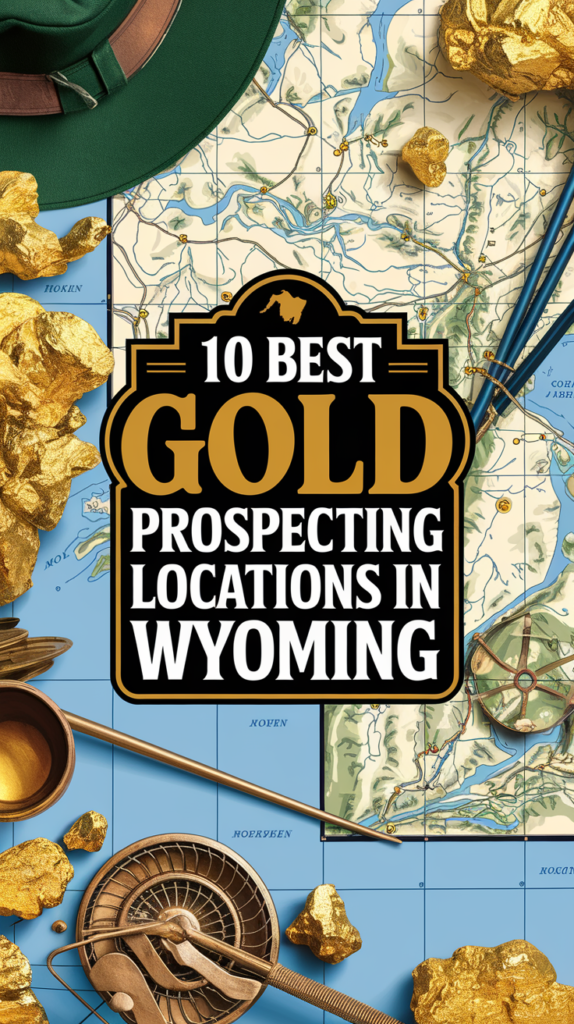
When it comes to striking it rich in the American West, Wyoming holds a special place in the hearts of gold prospectors. While not as famous as California or Alaska, Wyoming’s rugged terrain conceals countless golden treasures waiting to be discovered. As someone who’s spent years exploring the state’s diverse geological landscapes, I can tell you that gold hunting in Wyoming offers both exciting challenges and rewarding experiences. Whether you’re a seasoned prospector or just starting your golden adventure, these top 10 locations provide excellent opportunities for finding that precious yellow metal.
History of Gold Mining in Wyoming
Gold was first discovered in Wyoming during the 1840s, sparking several minor gold rushes throughout the territory. Unlike the massive rushes in neighboring states, Wyoming’s gold mining history has been characterized by steady, smaller-scale operations that have continued to this day. The South Pass area became particularly significant in the 1860s, producing millions in gold value and establishing Wyoming as a legitimate gold-producing state.
| Historical Period | Major Discoveries | Estimated Production |
|---|---|---|
| 1842-1860 | Initial Discoveries | Minimal |
| 1861-1880 | South Pass Gold Rush | $7 million |
| 1881-1900 | Douglas Creek Findings | $3 million |
| 1901-Present | Various Locations | $12+ million |
Top 10 Gold Prospecting Locations in Wyoming
1. South Pass Mining District
Located in Fremont County, the South Pass Mining District remains Wyoming’s most productive gold area. The district encompasses several historic mines and countless creeks perfect for panning. I’ve found that spring runoff creates ideal conditions for placer mining here. Access is relatively easy via Highway 28, though some areas require 4×4 vehicles.
2. Douglas Creek
Situated in the Medicine Bow Mountains, Douglas Creek has been a reliable producer of placer gold. The creek’s gradual slope and numerous gravel bars make it ideal for sluicing operations. From personal experience, the best results come from working the inside bends of the creek where gold naturally concentrates.
3. Seminoe Mountains
The Seminoe Mountains offer both placer and lode gold opportunities. The area’s complex geology has created numerous gold-bearing quartz veins. When prospecting here, focus on the weathered outcrops and stream gravels below them.
4. Atlantic City Area
Once a bustling mining town, Atlantic City’s surrounding area still yields good amounts of gold. The nearby Rock Creek is particularly productive. I’ve found that working the tailings from historic operations can be surprisingly rewarding.
5. Keystone Area
The Keystone area features several abandoned mines and productive streams. Look for black sand deposits, as they often contain fine gold. The area requires careful planning as some sections are on private property.
6. Medicine Bow Mountains
These mountains contain numerous gold-bearing streams and historic mining sites. The area’s geology is similar to Colorado’s rich mineral belts. Focus on areas where multiple streams converge.
7. Slate Creek
Slate Creek has consistently produced placer gold since the 1800s. The creek’s bedrock structure creates natural gold traps. Early morning prospecting tends to yield better results due to improved visibility in the water.
8. Little Laramie River
This river system offers excellent opportunities for recreational prospecting. The gentle gradient and accessible banks make it perfect for beginners. Look for areas where the river makes sharp bends.
9. Rock Creek Mining District
Located near Atlantic City, this district continues to produce both placer and lode gold. The area’s complex geology requires careful prospecting but can be highly rewarding.
10. Copper Mountain District
While primarily known for copper, this district also yields significant gold deposits. The weathered outcrops often contain visible gold specimens. Winter prospecting can be challenging but productive due to reduced competition.
Essential Equipment and Techniques
Every successful gold hunting expedition requires the right tools. Here’s what you’ll need:
| Equipment Type | Recommended Items | Estimated Cost |
|---|---|---|
| Basic Equipment | Gold pan, classifier, snuffer bottle | $30-50 |
| Intermediate Gear | Sluice box, shovel, rock hammer | $100-200 |
| Advanced Tools | Metal detector, highbanker | $500-2000 |
| Safety Gear | First aid kit, GPS, weather gear | $150-300 |
Key Techniques:
– Test pan multiple locations before settling on a spot
– Look for natural gold traps in bedrock
– Sample upstream from productive areas
– Work methodically and keep detailed records
– Process material in layers, starting from the bottom
Legal Requirements and Safety Considerations
Before heading out to prospect, ensure you:
– Obtain necessary permits from the BLM
– Research claim ownership
– Check local regulations
– Understand seasonal restrictions
– Carry appropriate insurance
Safety Tips:
– Never prospect alone
– Carry emergency communications
– Check weather forecasts
– Mark your prospecting locations
– Maintain proper hydration
Conclusion
Gold prospecting in Wyoming offers a unique blend of history, adventure, and potential rewards. While the days of major gold rushes may be past, dedicated prospectors can still find significant amounts of gold in these locations. Remember to always respect private property, follow local regulations, and practice responsible prospecting techniques. With proper preparation and persistence, you might just discover your own piece of Wyoming’s golden heritage.
Key Takeaways
- South Pass remains Wyoming’s most productive gold district
- Proper equipment and technique are crucial for success
- Always obtain necessary permits before prospecting
- Best results often come during spring runoff
- Research and preparation are as important as the actual prospecting
Frequently Asked Questions
Do I need a permit to prospect for gold in Wyoming?
Yes, you typically need a permit from the Bureau of Land Management (BLM) for prospecting on public lands. Some areas may require additional permits or have specific restrictions.
What’s the best season for gold prospecting in Wyoming?
Late spring to early fall offers the best conditions, with spring runoff often exposing new deposits. However, each location has its optimal season depending on accessibility and water levels.
Can I keep the gold I find?
Yes, if you’re prospecting legally with proper permits and on public land or claims you own/have permission to work, you can keep any gold you find.
What type of gold is most commonly found in Wyoming?
Placer gold is most common, typically found as small flakes and occasional nuggets. Lode gold in quartz veins can also be found in certain areas.
How much gold can I expect to find in a day?
Results vary greatly, but most recreational prospectors find anywhere from a few flakes to several grams per day, depending on location and experience level.
What’s the minimum equipment needed to start prospecting?
Basic equipment includes a gold pan, classifier, shovel, and snuffer bottle. These tools can be purchased for under $100 total.
Are there any restricted areas for gold prospecting?
Yes, national parks, private property, and active mining claims are restricted. Always verify land status before prospecting.
How can I identify potential gold-bearing areas?
Look for areas with historical mining activity, quartz outcrops, and places where water flow naturally slows down, such as bends in rivers and behind large boulders.
Is it worth getting a metal detector for gold prospecting?
While metal detectors can be useful, they’re not essential for beginning prospectors. Start with basic panning equipment and upgrade as you gain experience.
How do I clean and process the gold I find?
Most placer gold can be cleaned using final classification and separation with a snuffer bottle. For larger amounts, consider using specialized cleanup equipment like a Gold Cube or Blue Bowl.


